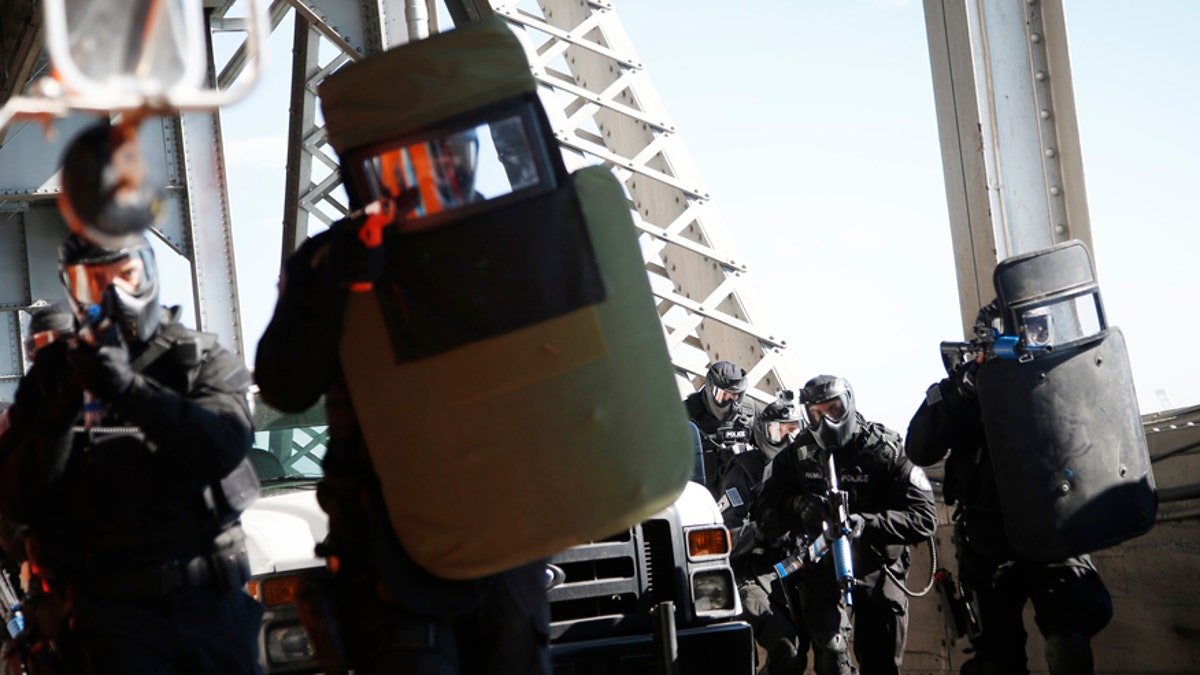
(Reuters)
The American police officer appears to have transformed into a soldier. This has become clear in recent years, from the tanks rolling through Boston after the Marathon bombing, to Oakland's violent response to the Occupy movement, to the rampant utilization of Special Weapons and Tactics (SWAT) teams on non-violent, low-level drug offenders.
This transformation is problematic and hinders true security. A militarized police force operates as if the community it serves is the enemy, breeding fear and mistrust of the police. This tension fuels chaotic interactions with the community and forceful responses from the police, making policing less effective and furthering the cycle of militarization.
[pullquote]
Much of this militarization stems from troublesome federal policies. Here's how it all began.
The first responsible federal program is the 1033 program, which allows the Department of Defense to transfer military-grade weapons, equipment, aircraft, and tactical vehicles to local American police units – for free. When the Pentagon has a surplus of military equipment – and there is always a surplus, due in part to large defense manufacturing contracts – the surplus is made available to local law enforcement agencies at no cost.
Excess M-16s, helicopters and even giant Mine-Resistant Ambush-Protected vehicles (MRAPs) can be seen not only on the battlefields of Afghanistan, but also on the streets of small-town America. Since the program's inception in 1996, the Pentagon has donated more than $4 billion worth of equipment and weapons to municipal law enforcement agencies.
In addition to directly distributing weapons to the police through the 1033 program, the federal government utilizes a second, equally troubling program to irresponsibly militarize police. These are grants handed out by the Department of Homeland Security, which provides cash to police officers across the country. This money is meant to combat the threat of terror, and it expressly allows police to purchase for themselves equipment that was once designed only for the battlefield.
Through these so-called "terror grants," local police have received more than $34 billion. Effects of this cash flow often border on the absurd. Fargo, N.D., is known as one of the safest areas in the United States, with an average of two homicides per year. Yet it has received $8 million through these grants, used to purchase an armored truck with a rotating turret, bomb-detecting robots and many other items.
Many law enforcement agencies have used their grant money to purchase drones. Most notably, the sheriff's department in Montgomery County, Texas, became the first local police agency to deploy a drone capable of carrying weapons. The hefty $300,000 was picked up by federal tax dollars.
Aside from the militarizing effects of these programs, there is rampant waste, fraud and abuse. There is no complete list of DHS grant recipients, and haphazard oversight of the 1033 program has resulted in heavy-duty military weapons being lost or illegally sold in bulk.
One of the most obvious ways that federal policies have militarized even routine police work can be seen in the rise of SWAT teams. With free equipment in plentiful supply, SWAT teams have sprung up across the country. As investigative reporter Radley Balko points out, once you have a SWAT team, you want to use it, which is clear from the nearly 150 SWAT raids that happen every day [SB1] in the United States. Once formed and armed, the SWAT teams are often utilized not for crises or emergencies, but for routine police work, such as low-level drug raids.
SWAT teams are showing up in surprising places. In recent years, even federal administrative agencies have employed SWAT-like special agents to conduct their law enforcement operations. The most shocking example occurred in 2011, when federal agents resembling SWAT officers forcefully executed a search warrant on a man's home in Stockton, Calif. The man was roughly detained, along with his three young children, for many hours. Imagine the man's surprise upon learning that the agents were from the Department of Education.
When the Department of Education has a SWAT team, a small-town sheriff operates a drone and a college campus has an MRAP, it is time to re-examine what exactly it means to protect and serve. To be sure, police officers require vital safety equipment, and circumstances do arise in the course of law enforcement that demand enhanced security measures. But policies that conflate law enforcement with military might threaten civil liberties and the true security of communities.
The federal government should not continue to arm police like soldiers, and it must not be so reckless with its dollars and weapons. The 1033 program and Homeland Security terror grants should be curbed and subjected to strict oversight. Further, an audit should take place to determine how many federal agencies in addition to the Department of Education employ SWAT-like law enforcement agents.
Effective law enforcement requires that the police serve as an integral part of their communities, instead of furthering a militant "us versus them" mentality through their appearance and behavior. Police officers cannot credibly forge relationships with their communities when they operate as a paramilitary unit. Serving and connecting with a community is more important, and more effective, than adhering to a bureaucratic military model.
Restructuring the militarized police will take political will. Members of Congress should support legislation reforming these programs, and constituents must encourage their elected officials to act. It is not acceptable to maintain the status quo. The police are not at war, and Americans are not the enemy.
